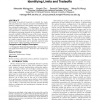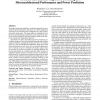ASPDAC
1995
ACM
14 years 3 months ago
1995
ACM
Most existing high-level synthesis(HLS) systems attempt to generate a circuit from a behavioral description \out of the void", using the entire design space as the search dom...
CODES
2001
IEEE
14 years 3 months ago
2001
IEEE
Comprehensive exploration of the design space parameters at the system-level is a crucial task to evaluate architectural tradeoffs accounting for both energy and performance const...
CASES
2003
ACM
2003
ACM
A hierarchical approach for energy efficient application design using heterogeneous embedded systems
14 years 3 months ago
Several features such as reconfiguration, voltage and frequency scaling, low-power operating states, duty-cycling, etc. are exploited for latency and energy efficient application ...
CODES
2004
IEEE
14 years 3 months ago
2004
IEEE
We present a analytical framework to identify the tradeoffs and performance impacts associated with different SoC platform configurations in the specific context of implementing m...
ASPLOS
2006
ACM
14 years 3 months ago
2006
ACM
We propose regression modeling as an efficient approach for accurately predicting performance and power for various applications executing on any microprocessor configuration in a...
ASPLOS
2006
ACM
14 years 3 months ago
2006
ACM
Architects use cycle-by-cycle simulation to evaluate design choices and understand tradeoffs and interactions among design parameters. Efficiently exploring exponential-size desig...
ACMDIS
2000
ACM
14 years 3 months ago
2000
ACM
Rapid technological change requires that system designers explore potential design spaces widely before committing to a local design space in which to evolve a problem solution. W...
IPPS
2000
IEEE
14 years 3 months ago
2000
IEEE
The switch design for interconnection networks plays an important role in the overall performance of multiprocessors and computer networks. It is therefore crucial to study variou...
INFOVIS
2000
IEEE
14 years 3 months ago
2000
IEEE
COMIND is a tool for conceptual design of industrial products. It helps designers define and evaluate the initial design space by using search algorithms to generate sets of feasi...
HPDC
2002
IEEE
14 years 4 months ago
2002
IEEE
Resource location (or discovery) is a fundamental service for resource-sharing environments: given desired resource attributes, the service returns locations of matching resources....






